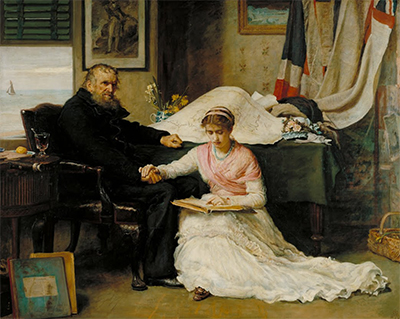The North-West passage by John Everett Millais is an oil painting on canvas, painted in 1874. In it, an elderly sailor is seated at a desk, looking directly out of the painting at the viewer. He is unsmiling and has a concerned expression on his face. Seated on a stool at his feet, his daughter is reading to him from a book.
It is likely that this is a ship's log book, probably from one of the retired sailor's earlier voyages at sea. The daughter's expression is calm and demure. The sailor is sitting beside a large desk covered with a green clothe. On the table, there are large and complex charts depicting sea routes and crossings. For the painting of this picture, Millais used his friend Edward John Trelawny, a retired sea captain, as a model for the retired sailor, although it was not an easy task to persuade him to sit. In fact, it was Millais wife who managed to persuade him, by agreeing to repeatedly visit a Turkish bath in London which Trelawny was promoting, in return for sitting for the painting.
The daughter was modelled by Mrs. Ellis, a professional model who also modelled for Millais in the 1876 painting Stitch, Stitch, Stitch. Originally, the painting featured two of Millais children playing with a globe on the right of the painting but Millais was unhappy with the result, believing that it distracted the eye from the main subject of the painting. He subsequently replaced the children with the large screen, across which are draped British naval flags. In the detail of the painting there is evidence of the real efforts being made to find a north-west passage around the Americas. The charts on the desk depict the northern coast of Canada, as charted during the Robert McClure expeditions of 1848 - 1853.
The painting on the wall in the background, partly obscured by the flags, depicts a ship trapped in ice. It resembles McClure's ship which had to be abandoned after becoming trapped in 1853, so it would seem that Millais is suggesting that the sailor was part of that expedition to find the passage. Upon seeing the painting at the Royal Academy exhibition in 1874, teetotal Trelawny was outraged to see that Millais had painted in a glass of grog. However, he later decided that Millais' wife was probably to blame, owing to her Scottish heritage. The painting can currently be seen at the Tate Gallery in London.




